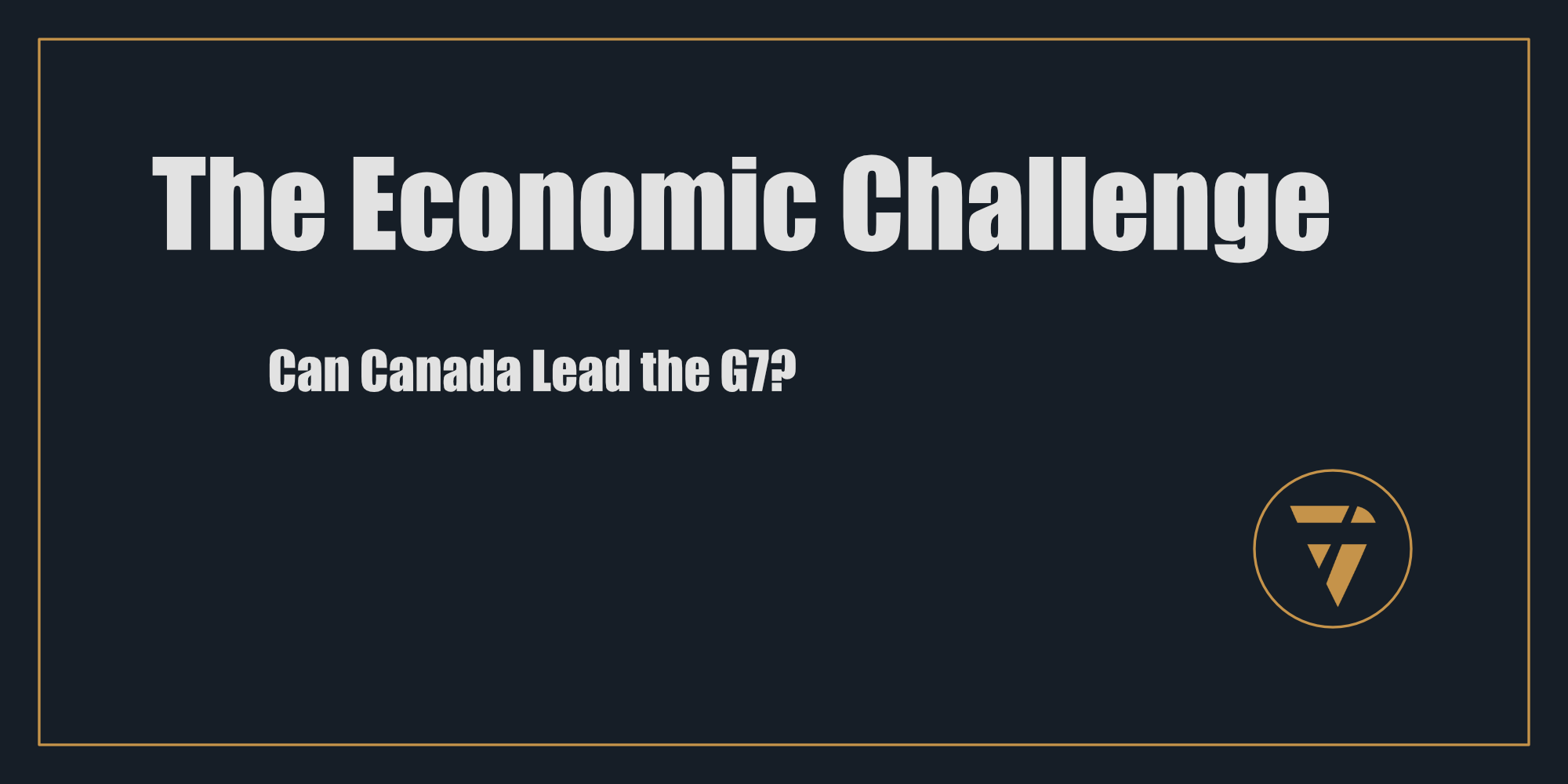The Economic Challenge

Can Canada Lead the G7?
Mark Carney’s economic vision presents a compelling blueprint for positioning Canada as the strongest economy in the G7. His policies emphasize fiscal responsibility, industrial modernization, and global competitiveness, but their success will depend on execution. The Canadian economy faces structural challenges, including lagging productivity, an affordability crisis, and a workforce struggling to adapt to rapid technological shifts. While Carney’s approach is built on sound economic principles, the strategy demands refinement, deeper integration with business and industry, and more immediate implementation to ensure tangible benefits.
The policies he proposes focus on long-term economic transformation but must deliver visible results within the first 100 days to gain momentum and secure public confidence. A comprehensive strategy must ensure that investments in innovation and industrial growth reach not only large corporations but also small and mid-sized businesses that form the backbone of the economy. Workforce development must go beyond traditional education reform, integrating real-time data on industry needs with practical training programs that align with new economic opportunities. Energy policy must balance environmental goals with economic stability, ensuring that Canada remains an energy leader while making the transition to sustainable alternatives. Finally, trade and financial policy must evolve to create more diversified international relationships and position Canada as a key player in global economic governance.
Immediate Execution Plan for Sustainable Growth
To drive Carney’s vision effectively, Canada must begin with an immediate execution plan that delivers quick economic gains while laying the foundation for long-term prosperity. Economic policy is often judged by its short-term impact, making it critical to show tangible improvements in affordability, wages, and business confidence in the early stages of leadership, regardless of the long-term vision.
One approach is to launch an SME fast-track investment program that provides immediate tax credits and low-interest financing to businesses investing in automation, AI adoption, and workforce training. This would accelerate productivity gains across multiple industries, ensuring that small and mid-sized businesses—not just corporate giants—benefit from economic modernization. A middle-class affordability guarantee could further support wage growth and cost-of-living stability by accelerating housing supply expansion, implementing grocery price stabilization strategies, and reforming homeownership incentives to make housing more accessible. Conversations about localized secure food delivery systems will be necessary.
To ensure economic expansion benefits all regions, infrastructure and industrial acceleration initiatives must be prioritized. Rather than waiting for long bureaucratic processes to approve major industrial projects, pre-approved private-sector contracts could be used to fast-track energy, transportation, and digital infrastructure developments. This would not only create jobs immediately but also lay the foundation for long-term industrial competitiveness.
Business-Driven Industrial and Productivity Growth
Carney’s plan rightly focuses on industrial revitalization, but successful execution depends on direct business engagement. Industrial policy must be driven not just by government-led initiatives but by partnerships with entrepreneurs, mid-sized businesses, and corporate leaders who are actively investing in growth.
A private-sector investment matching program would help businesses scale by co-investing alongside venture capital firms and industry leaders. This approach would enable the government to de-risk early-stage innovation while ensuring that private capital plays a leading role in funding expansion. Another initiative would be an automation and AI adoption strategy targeted at small and mid-sized businesses, ensuring they can integrate new technologies into their operations without facing prohibitive costs.
Industrial modernization must be accelerated through a fast-track policy execution framework that removes bureaucratic delays and streamlines approvals for manufacturing, biotech, and fintech investments. If Canada is to become a global leader in innovation, it must create an environment where companies can scale quickly and efficiently without being bogged down by regulatory obstacles.
A Scalable Workforce and Skills Pipeline
One of the greatest risks to Carney’s plan is the gap between industrial modernization and workforce readiness. Technological transformation will be meaningless if Canada does not have a workforce equipped to take advantage of new economic opportunities.
A national apprenticeship program backed by industry leaders would ensure that companies actively participate in training the next generation of workers. Rather than relying solely on university education, Canada should integrate industry-backed skills development programs that transition workers directly into high-demand fields. AI-driven skills matching should also be implemented, allowing job seekers to be matched with training programs and employers based on real-time labour market data.
Beyond training programs, Canada must also address the challenge of talent retention. Too often, highly skilled professionals and entrepreneurs leave for opportunities in global markets. A national talent retention strategy should include targeted incentives for Canadian tech and business leaders to scale their ventures within Canada, ensuring that economic growth is driven by domestic innovation.
A Balanced and Realistic Energy Transition
Carney’s commitment to climate leadership is essential, but a pragmatic approach must balance environmental responsibility with economic stability. Canada’s energy economy cannot simply be dismantled in favour of green alternatives; rather, it must evolve strategically to ensure that resource sectors remain globally competitive, while investing in sustainable energy development.
Canada has the potential to become a leader in clean energy exports, but this requires a framework that integrates carbon capture and battery technology development. Investments in AI-driven energy efficiency will also be critical, allowing existing industries to reduce emissions while maintaining economic productivity. To achieve this, clean energy infrastructure projects must be approved at a faster pace, eliminating unnecessary bureaucratic hurdles that often delay progress.
One of the key strategies in making Canada an energy powerhouse is ensuring that energy policies align with global economic trends. Instead of focusing solely on domestic energy policies, Canada should pursue strategic energy export agreements with Europe and Asia, positioning itself as a long-term supplier of clean energy and critical minerals. This approach would allow the country to benefit economically from the global energy transition rather than merely reacting to external market forces.
A Competitive Global Trade and Finance Model
Carney’s global trade and financial leadership experience provide Canada with a unique opportunity to expand beyond its traditional reliance on U.S. markets. Canada’s trade policy should focus on deeper engagement with emerging markets in Southeast Asia and Latin America, reducing dependency on North American supply chains. This diversification would insulate the Canadian economy from geopolitical risks, while creating new growth opportunities.
In addition to trade expansion, Canada must position itself as a leader in fintech and AI-driven banking. The future of financial markets will be shaped by digital innovation, and Canada has the potential to become a hub for responsible investment, digital finance, and regulatory leadership. By creating a streamlined regulatory framework that encourages fintech startups to scale within Canada, the country can strengthen its financial sector, while attracting global investment.
One of the most effective ways to drive long-term investment is to implement a regulatory fast-lane for fintech and high-growth investment funds. If Canada can simplify the process for financial innovation, it can position itself as a preferred destination for global capital, accelerating economic expansion while maintaining responsible financial governance.
Making Carney’s Vision a Reality
Mark Carney’s leadership presents an opportunity to reposition Canada as a global economic force, but execution will determine whether his vision succeeds. His policies must go beyond macroeconomic stability and create real, tangible improvements in wages, business growth, and industrial competitiveness.
To support and improve his strategy, economic policy must be built around direct engagement with businesses, ensuring that small and mid-sized companies play a leading role in economic modernization. Industrial growth must be accelerated through investment incentives and fast-tracked policy execution. Workforce development must integrate real-time industry data with training programs that prepare Canadians for new economic opportunities. Energy policy must be realistic, allowing Canada to remain a global leader while transitioning toward sustainability. Trade and financial policies must evolve to position Canada as a diversified, competitive force in international markets.
Carney’s leadership has the potential to create the most significant economic transformation in Canadian history, but only if his policies translate into immediate, measurable results. The success of his vision depends on balancing long-term economic expansion with short-term wins that build public trust and business confidence. If executed correctly, Canada will not only strengthen its position within the G7, but also become a global leader in innovation, energy, and financial governance.
This is what I’m working on. Tell me what you think, I enjoy the conversation! Subscribe and follow the work in real time.
Thanks!
B

Canada’s economic future won’t be shaped by promises, it will be built by execution. Growth comes from investment, workforce readiness, and a strategy that delivers results. Vision is the start, but action decides if Canada leads, or falls. The time to build is now.
PS -






